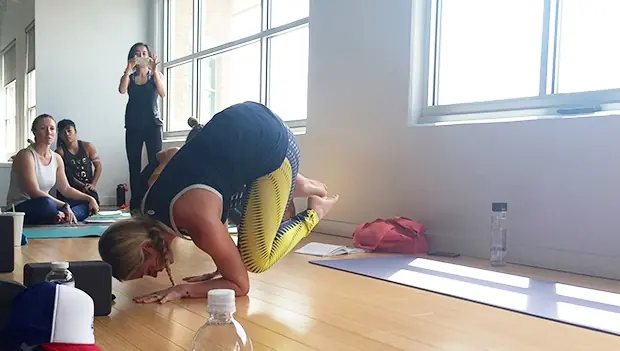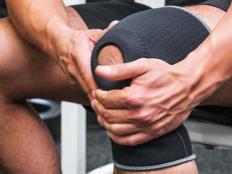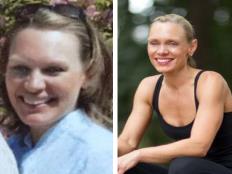
The next two days each featured two long workshops. There was a lot of movement, and I can't remember the last time I was that sore, but there were also breaks that provided a chance to learn and take notes.
Throughout this weekend, my brain constantly felt overloaded with information.
Take a backbend: Sounds simple enough to the average person — lean on back, right?
Here are my notes from what she said about backbends: "Keep pelvis neutral; engage lower body; don't totally engage the butt; keep an internal rotation of your upper, inner legs; feet hip-width apart; arms shoulder-width apart."
Remember all of this at once and breathe.
The workshop titled "Keep Calm and Bakasana On" was two and a half hours spent in variations of crow pose (bakasana), where you balance on your hands and lift your knees to your upper arms.
Budig said it's not uncommon to have little bruises up and down the triceps after this workshop. I instantly thought, "Crap, that'll be me." But I didn't get little bruises. I got large bruises on the backs of my arms.
"I want you to be a little cocky," she said when some of us started to feel insecure about a difficult transition. "Just think, 'This is my body, and this is what I want it to do.'"
Simple enough, right? And that was her point: She frequently emphasized to not think too much about it.
"Just put it on repeat and don't analyze," she said. "Don't try to wrap your brain around it, because it'll never make sense."
Budig's Impact
I was surprised at how loud the studio got at times. It's not a giant room, but it was packed, and once people started moving, voices filled it. But when Budig demonstrated something, the room would become eerily quiet.
I became a fan of Budig's through YogaGlo years ago. I've seen her demonstrate inversions and transitions many times on the screen of my laptop, but it's different watching her in person.
She can hold her entire body weight on her hands with what looks like such ease. As many of us gawked at this, she reminded us that we could do it, too, after putting in the work.
"It's not because I was born to do it, but because I've done it many, many, many, many times," said Budig, who was first trained in ashtanga — a type of yoga that frequently involves supporting your own body weight.
More: 8 Types of Yoga Explained
She was open to anyone who wanted to talk to her, and she was happy to sit down with me so ACTIVE.com readers could get to know her a little more.
Before we got into yoga on the first day, she explained Aim True. I've seen that she's been using #AimTrue in her social posts, and that night, I heard her elaborate on this philosophy. We got an abridged version that she expands upon in her book by the same title, set for release in March 2016.
"The heart of it is the Aim True message, so it's basically my philosophy and how it applies to all aspects of life. And I've been breaking it down to how it applies to the mind, how it applies to the physical body, how it applies to what we eat, how it applies to how we interact with people in our lives," she said.
Throughout the weekend, Budig mentioned how ashtanga gave her the ability to hold her body weight. She credited the style with getting her used to working hard in practice, but that's not necessarily her focus today.
"That practice is also very fiery, and as I started to become busier and busier in my life, I needed something to complement all the fire in my life — and I found that it was just too much fire."
- 2
- of
- 3
Get ACTIVE on the Go


Couch to 5K®
The best way to get new runners off the couch and across the finish line of their first 5K.
Available for iOS | Android






Discuss This Article